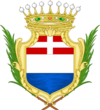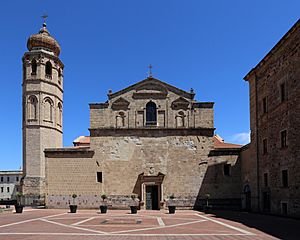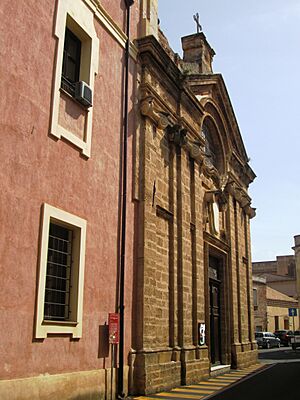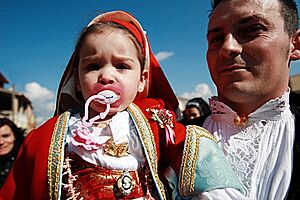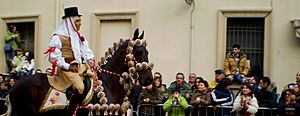Oristano facts for kids
Quick facts for kids
Oristano
Aristanis (Sardinian)
|
|||
|---|---|---|---|
| Comune di Oristano | |||

Oristano: Statue of Eleanor of Arborea, holding the Carta de Logu in her hand, with the sundial on the wall of the City Hall in the backdrop.
|
|||
|
|||
| Country | Italy | ||
| Region | Sardinia | ||
| Province | Oristano (OR) | ||
| Frazioni | Donigala, Massama, Marina di Torre Grande, Nuraxinieddu, Silì, Torre Grande | ||
| Area | |||
| • Total | 84.57 km2 (32.65 sq mi) | ||
| Elevation | 10 m (30 ft) | ||
| Population
(31 December 2017)
|
|||
| • Total | 31,671 | ||
| • Density | 374.495/km2 (969.94/sq mi) | ||
| Demonym(s) | Oristanesi Aristanesus |
||
| Time zone | UTC+1 (CET) | ||
| • Summer (DST) | UTC+2 (CEST) | ||
| Postal code |
09170
|
||
| Dialing code | 0783 | ||
| Patron saint | St. Archelaus | ||
| Saint day | February 13 | ||
Oristano is a city in Italy. It's the main city of the Province of Oristano on the island of Sardinia. Oristano is located in the central-western part of Sardinia, on a flat area called the Campidano plain. It became the capital of its province on July 16, 1974. In December 2017, about 31,671 people lived there. The city's economy relies mostly on services, farming, tourism, and small businesses.
Contents
History of Oristano
Oristano was once known by the Byzantines as Aristianis límni, which means "Pond of Oristano." It was built near an old Phoenician town called Othoca, which is now Santa Giusta.
Oristano became important around the year 1070. At that time, people were often attacked by the Saracens. Because of these attacks, the Archbishop Torcotorio moved the main church from the coastal town of Tharros to Oristano. This made Oristano the new center for the church.
The city also became the capital of a "Judicate" called Judicate of Arborea. A Judicate was like a small kingdom in Sardinia. Because it was so important, people started to plan strong walls to protect the city. However, these walls were not fully built until Judge Mariano II came to power.
In the Middle Ages, Oristano wanted to rule all of Sardinia. This led to wars with other Sardinian kingdoms. The most famous attempts to conquer the island happened during the rule of Mariano IV (from 1347 to 1375), his son Hugh III (from 1376 to 1383), and his daughter Eleanor (from 1383 to 1404).
The Judicate of Arborea was the last Sardinian kingdom to remain independent. It finally ended in 1420, about 10 years after the battle of Sanluri. The Aragonese, who were from Spain, then turned Oristano into a "Marchesato." After a revolt by the last ruler, Leonardo Alagon, the city was taken over by Catalan troops from the Kingdom of Aragon in 1478, after the Battle of Macomer.
After this, Oristano's history was similar to the rest of Sardinia. It was ruled by the Aragonese-Spanish until 1708, and then by the Piedmontese from 1720. Eventually, it became part of the unification of Italy. In April 1921, important Sardinian veterans from World War I, like David Cova and Emilio Lussu, started the Sardinian Action Party in Oristano.
Main Sights to See
Oristano has many interesting old buildings and churches to visit:
- The Tower of St. Christophoros: Also known as the Tower of Mariano II, this tower was built in 1290. It is 19 meters (about 62 feet) tall. It's one of the best remaining parts of the old city walls from the time of the Judicate, and it used to be one of the main gates into the city.
- Torrione of Portixedda: This is another large tower that was part of the old city defenses.
- St. Mary's Cathedral: The original cathedral was built in 1130. It was rebuilt after being damaged in a siege. Today, only parts of the back section and the base of the bell tower are left from the original building. There's also a Gothic chapel inside with medieval sculptures. You can see parts of an even older Byzantine building in the courtyard. The cathedral was restored in the 19th century and now looks mostly Baroque. It's thought that the Judges and their families were buried here, but their tombs are gone. Inside, there's a wooden statue of the Annunziata, possibly made by Nino Pisano.
- The Church of St. Francis of Assisi: This church was built around 1200 and now has a neo-classical style. Inside, you can see the "Christ of Nicodemus," a wooden sculpture from the 14th century.
- The Franciscan church of Santa Chiara: This church was finished in 1428. It's built in a French-Gothic style with one main room and a square back section.
- The Church and cloister of the Carmine: This is a beautiful example of Baroque and Rococo architecture in Oristano.
- The Church of Saint Sebastian: This is the only medieval church that was built outside the city walls.
- The Church of Saint Dominic: Built in 1634, this church was supported by a local nobleman and donations from citizens. It has a rectangular shape with two chapels on the right side. It also features a wooden altar with statues of Saint Dominic and other saints. Today, it is no longer a church but an auditorium for events.
- Oratory of the Souls: In the village of Massama, there's a small church called the Oratory of the Souls. It's very old, from before the Roman times, and shows influences from 8th-century Visigothic art.
Culture and Events
Sa Sartiglia: A Horse Tournament
Sa Sartiglia is a special horse tournament that has been held in Oristano for over 500 years! It takes place every year on Carnival Sunday and Mardi Gras. On Sunday, it's organized by the farmers' group (called a gremio). On Mardi Gras, the carpenters' group organizes it.
Some people think this tournament came from Spain a long time ago. However, some local historians believe it started in Oristano even before the Spanish arrived. For example, a letter from the 14th century mentions that the ruler of Arborea could provide many horsemen. This shows how important horses were in Oristano back then.
The name "Sartiglia" comes from the word Sortija, which means "ring." This word itself comes from the Latin word Sorticola, meaning "little ring."
How Sa Sartiglia Works
The main goal of Sa Sartiglia is to catch a small tin star with a hole in its center. The star hangs from a ribbon stretched high across a street near the cathedral. Masked horsemen ride their horses at incredible speed, trying to hit the star with their swords. Trumpets and drums announce their arrival, and they gallop down a sandy path through the town center.
The number of stars caught each day is believed to show how much good luck and wealth the farmers and carpenters will have in their work.
La Pariglia: Acrobatics on Horseback
After Sa Sartiglia ends, another exciting event called La Pariglia takes place. This happens on a different sandy path within the old city walls. The same masked horsemen and women show off their amazing skills. They perform all sorts of acrobatics, sometimes riding on two or even three galloping horses at once! This part of the event finishes at sunset.
Su Componidori: The Leader
The leader of both Sa Sartiglia and La Pariglia is called Su Componidori. This name means "the one who marshals" or "the one who organizes." This special person is chosen by the members of the groups. Their name is kept secret until a specific day in February.
Su Componidori is seen as neither male nor female, but as a special, neutral figure. At the end of the tournament, this leader blesses the crowd and the town. They use a bunch of flowers wrapped in a ribbon, called "the little doll of May" (Sa Pippia 'e maiu). This tradition is thought to be even older than the tournament itself. Finally, Su Componidori rides alone, sometimes even with their back to the horse, looking up at the sky.
Getting Around Oristano
You can reach Oristano by train from Sardinia's ports like Olbia and Porto Torres. You can also get there from the island's main cities, Cagliari and Sassari.
From Oristano, you can take buses to all the villages in the province. The bus station is near Piazza G.Manno in the city center. There's also a private bus service that goes to and from Cagliari Elmas Airport twice a day. The trip takes about 2 hours.
Oristano also has the Fenosu Airport, which is about 3 kilometers (2 miles) from the city. There's also a cargo sea port. However, the airport is not currently operating for passenger flights.
Climate in Oristano
Oristano has a subtropical Mediterranean climate. This means it has hot summers and mild winters. Most of the rain falls during the winter months. Even in summer, the nights can still be warm and humid, even though the days are dry.
| Climate data for Oristano, Sardinia | |||||||||||||
|---|---|---|---|---|---|---|---|---|---|---|---|---|---|
| Month | Jan | Feb | Mar | Apr | May | Jun | Jul | Aug | Sep | Oct | Nov | Dec | Year |
| Mean daily maximum °C (°F) | 13.2 (55.8) |
13.2 (55.8) |
14.7 (58.5) |
16.7 (62.1) |
20.8 (69.4) |
24.5 (76.1) |
27.8 (82.0) |
28.8 (83.8) |
26.0 (78.8) |
21.9 (71.4) |
17.3 (63.1) |
14.4 (57.9) |
19.9 (67.8) |
| Daily mean °C (°F) | — | — | — | — | — | — | — | — | — | — | 11.3 (52.3) |
8.8 (47.8) |
— |
| Mean daily minimum °C (°F) | 7.6 (45.7) |
7.5 (45.5) |
8.6 (47.5) |
10.3 (50.5) |
13.7 (56.7) |
17.3 (63.1) |
20.1 (68.2) |
21.1 (70.0) |
18.7 (65.7) |
15.3 (59.5) |
11.3 (52.3) |
8.8 (47.8) |
13.4 (56.1) |
| Average rainfall mm (inches) | 50.0 (1.97) |
60.5 (2.38) |
44.4 (1.75) |
51.4 (2.02) |
32.8 (1.29) |
16.7 (0.66) |
4.4 (0.17) |
7.3 (0.29) |
34.2 (1.35) |
69.7 (2.74) |
92.5 (3.64) |
65.0 (2.56) |
528.9 (20.82) |
| Average rainy days (≥ 1 mm) | 8 | 8 | 7 | 8 | 5 | 2 | 1 | 1 | 4 | 8 | 10 | 9 | 71 |
Twin Towns – Sister Cities
Oristano has special friendships with other cities around the world. These are called "twin towns" or "sister cities":
 Ciutadella de Menorca, Spain, since 1991
Ciutadella de Menorca, Spain, since 1991 Garden City, Kansas, United States
Garden City, Kansas, United States
See also
 In Spanish: Oristán para niños
In Spanish: Oristán para niños



